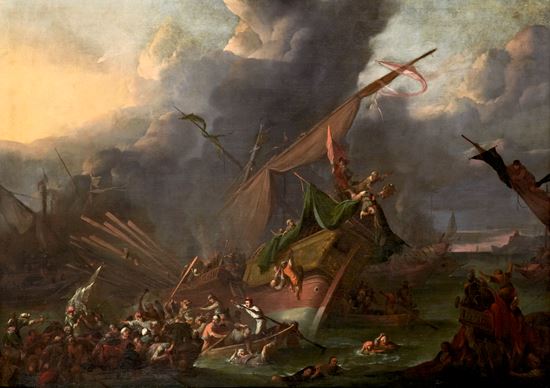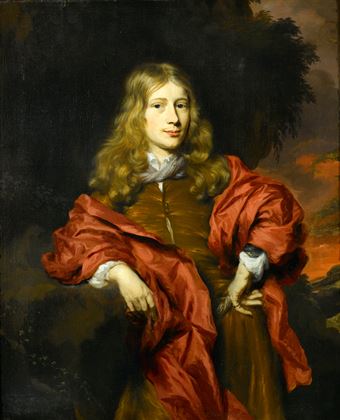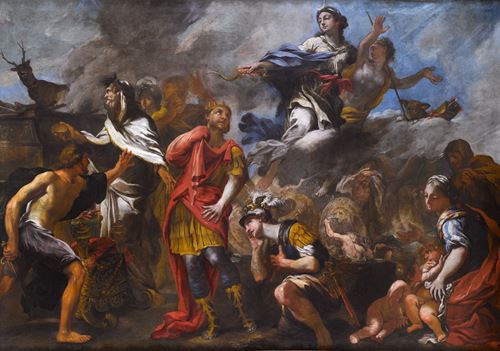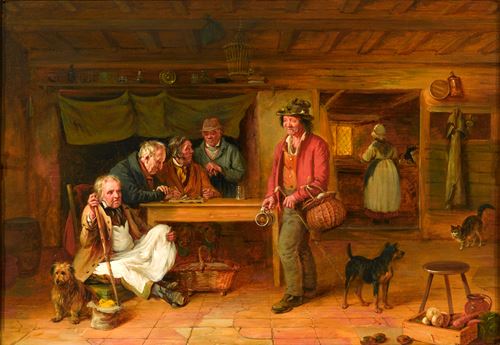ohannes Lingelbach
(Frankfurt 1622 - Amsterdam 1674)
The Battle of Lepanto
signed and dated ‘I LINGELBACH 16**’ (on spar, lower centre)
oil on canvas
107 x 147 cm (42 x 58 in)
Don John pounding from the slaughter-painted poop,
Purpling all the ocean like a bloody pirate’s sloop,
Scarlet running over on the silvers and the golds,
Breaking of the hatches up and bursting of the holds,
Thronging of the thousands up that labour under sea
White for bliss and blind for sun and stunned for liberty.
- G. K. Chesterton, Lepanto, 1915.
This catastrophic battle scene most probably represents the naval defeat of the Ottoman Turks by the combined forces of Spain, Venice and the Papacy under the command of Don John of Austria at Lepanto (Inehbati) in 1571. It took place after the Turkish fleet left Lepanto harbour on the 6 October, 1571 and made its way down the Gulf of Patras towards the open Ionian Sea.
During the sixteenth century, while Christendom was expanding across the Atlantic to the Americas, it was contracting in the Mediterranean as the Ottoman Sultan’s power threatened to engulf western Christendom. At Lepanto, this remarkable and decisive victory by the Holy League permanently destroyed Ottoman naval power in the Mediterranean.
The passionate intensity of the battle is palpable in The Battle of Lepanto. The composition is dominated in the centre by a dramatically sinking galley - its stern receding into the murky green water as the helpless oars point skywards. On a Turkish vessel captured by the Christians, a victorious Christian seaman stands atop the bow proudly waving a red flag while nearby, turbaned Ottoman sailors throw themselves overboard to escape the imminent disappearance of the vessel into the dark waters.
Surrounding the sinking vessel are several rowboats crammed with Christian and Turkish sailors fighting to save themselves from certain death. The savagery of the fighting is etched on the faces of the sailors as combat progresses to basic hand-to-hand fighting. Some Turkish sailors use curved swords for defence - the bloodied heads of several seamen highlighting their deadly effectiveness. Others use bow and arrow, whilst Christian sailors fire muskets into the neighbouring enemy rowboat. The ferocity of the activity in the water is further exacerbated by Lingelbach’s skilful use of directed chiaroscuro in the foreground, revealing the Italian influence of Caravaggio (1571-1610). Here a shaft of light, the source unknown, is cast across the water illuminating the struggle of the desperate, embattled sailors. The rowboats are clearly not the only theatre of war as two sailors continue to scrap in the open water - one holding a dagger above the head of another.
A rising plume of thick, grey smoke fills the sky in the background suggesting many vessels have been destroyed by superior firepower. Within this ghostly mist the outlines of numerous other galleys still engaged in battle can just be made out. In the right foreground the last moments of a sinking vessel are seen as the ornate bow is all that is left above water; sailors desperately holding on for safety. In the distant background, one can just make out the jagged, rocky Greek peninsular.
The Battle of Lepanto took a mere five hours to complete and was fought off the northern edge of the Gulf of Patras in western Greece. The Christian force had gathered at Messina, Sicily in July and August and comprised vessels from Venice, Spain, the Papal States, Genoa, Savoy, and Malta. This fleet of the Christian alliance was manned by 12,920 sailors and carried almost 28,000 fighting troops. In October they made their way east to catch the Turkish fleet as it left the harbour at Lepanto and headed towards the Ionian Sea. Numerically, the Turks had a considerable advantage with some 270 ships pitted against Don John’s 208. Ottoman scouts had informed their commanders about the presence of a Christian fleet in Cephalonia. Calling a war council on the 4 October, the Petrev Pasha, commander-in-chief of the 1571 campaign and Uluc Ali Pasha, governor of Algiers advised that the Ottoman fleet take up a defensive position in the gulf of Lepanto citing the diminished manpower of their navy. However, Moezzinzade Ali, the charismatic Admiral of the Navy, made the ill-fated decision to attack the Christian fleet. Ultimately, the Holy League was far better equipped in terms of firepower with 1,800 guns to the Turks’ 750. As the fleets sighted each other outside Lepanto they formed for battle. Don John aimed at a breakthrough by head-on collision and victory by close fighting - a tactic well documented by the present work.
The Holy League was divided into four divisions: the Venetians under Agostino Barbarigo on the left, Don John in the centre, the Genoese under Giovanni Andrea Doria on the right, and a reserve led by Álvaro de Bazán bringing up the rear. The Ottoman fleet was led by the Grand Admiral Ali Pasha (who died in combat) with 13,000 sailors and 34,000 soldiers. Disastrous for the Turks was the positioning of six Venetian galleasses (large galleys that carried substantial artillery power) which rammed enemy vessels and used their considerable fire-power to sink an estimated seventy Ottoman ships.
The Holy League victory was devastating for the Ottomans. While 15,000 Christians perished, Turkish losses were double that as well as 113 of their galleys sunk and 117 more captured. Lepanto was the biggest battle of the sixteenth century and was the last major naval battle fought primarily between rowing vessels.
The Battle of Lepanto was a popular subject for artists who sought to illustrate the victory of Christendom over the East. Unsurprisingly, the scene was glorified by the Venetian artists Veronese and Titian soon after the battle.¹ The Venetian fleet was internationally renowned for its technological advancement and its crucial role in the victory over the Turks only further strengthened the Republic’s naval reputation. Clearly these two works - Veronese’s interpretation showing divine intercession assisting the Holy League - were commissioned as propaganda in the ongoing confrontation with the East.
Lingelbach’s The Battle of Lepanto was painted nearly a century after the celebrated battle took place. But the subject evidently fascinated the artist who painted at least three other versions of the battle. That Lingelbach is known to have painted the subject in three further, though different, compositions shows how the victory, and its significance, reverberated into the seventeenth century.² Furthermore, by the seventeenth century a taste had developed for maritime and battle scenes with artists such as Willem van de Velde the Elder (1611-1693), Willem van de Velde the Younger (1633-1707) and Ludolph Backhuysen (1631-1708) promoting the genre. In particular, as the Dutch built up their navy, collectors - filled with nationalistic sentiment, mercantile success and a new interest in naval history - commissioned these works with gusto.
Evidently Lingelbach sought to satisfy this demand and, as well as the collection of paintings on the battle of Lepanto, he painted scenes of Dutch and Flemish warfare.³ Flemish Town Taken by Spanish Soldiers, is an excellent example of this genre and, as with The Battle of Lepanto, shows Lingelbach’s exceptional skill for representing the human aspect of battle within a large-scale composition. This scene illustrates the appropriation of the Southern Netherlands by the Spanish who held the ‘Spanish Netherlands’, including Flanders, from c.1579 to 1713.
The foreground, dominated by official tents, huddles of troops and general commotion leads the viewer’s eye to the vast military encampment that expands to the horizon; the skyline of the Flemish town just visible in the far distance. The compositional structure of Flemish Town Taken by Spanish Soldiers is similar to the present work. Though the foreground activity is the predominant subject in both paintings, it is the frenetic movement in the background that adds drama to the location - the inclusion of distant vessels engulfed in smoke is just as effective as row upon row of tents in setting the scene. Furthermore, Lingelbach has positioned a large grouping of figures in the foreground of both paintings, taking great care to show their individual expressions and gestures to add character to the works.
Johannes Lingelbach was born in Frankfurt but by 1634 his family had settled in Amsterdam. According to the Dutch painter and writer Arnold Houbraken (1660-1719), Lingelbach went to France in 1642 and continued to Italy in 1644 - though he is not mentioned in any document in Rome until 1647 - and where he left in 1649. By 1653 he was back in Amsterdam where he remained until his death in 1674.
A Dutch Italianate and one of the second generation of Bamboccianti, the development of Lingelbach’s career can be fairly well documented due to his frequent signing and dating of works. He is perhaps most well-known for his large compositions such as Market in the Piazza Navona (Städelsches Kunstinstitut und Städtische Galerie, Frankfurt) and Carnival (Kunsthistorisches Museum, Vienna). These charming, bustling Roman piazzas are filled with figures where Lingelbach has deftly utilised - as with The Battle of Lepanto and Flemish Town Taken by Spanish Soldiers - a diminishing background to effectively create a sense of space by means of light and mathematical perspective.
As well as busy piazzas, Lingelbach was also known for his scenes of Italian ports populated by Turks, merchants, gamblers, and peddlers. Therefore it was possibly his interest in exotic, oriental mercantile scenes that inspired him to paint The Battle of Lepanto and the companion versions.
An excellent painter of characteristic figures in wider, often crowded, landscapes, Lingelbach was frequently called upon to painted staffage for fellow artists, for example Meindert Hobbema (c.1638-1709) and Jacob van Ruisdael (1628-9-c.1682). Deer Hunt, a collaborative work with Jan Hackaert is a delightful example of Lingelbach’s skill for small-scale figures and animals. Here, deer and dogs elegantly leap forward in the foreground as they are pursued by a mounted hunter charging along the edge of a lake.
¹ There are two representations of the battle in the Palazzo Ducale, Venice - including a painting by Veronese in the Sala del Collegio and another by Andrea Vincentino (c.1542-1617) in the Sala dello Scrutinio, which replaced Tintoretto’s Victory of Lepanto, destroyed by fire in 1577.
² Sale, Sotheby’s, London, 6 July, 2006, lot 267 (unsigned, on canvas, 114.7 x 161.4 cm); Sale, Bukowskis, 24 November, 1999, lot 425.
³ See for example: Johannes Lingelbach, Battle Scene, 1671, Metropolitan Museum of Art, New York; Attributed to Johannes Lingelbach, Battle Scene, c.1651-1652, Getty Museum, Los Angeles.
Johannes van Wessem;
his sale, Utrecht, 26 July 1786, lot 260;
Le Comte de Budé de Ferney;
his sale, Paris, 8 April 1864, lot 43;
M. Le Chanoine Barbier, Nancy;
his sale, Brussels, Fievez, 12-13 June 1912, lot no 128.
Catja Burger-Wegener, Johannes Lingelbach,1622-1674, Ph.D. diss., Freie Universität, Berlin, 1976, no. 221 (where dated 1670?).
Don John pounding from the slaughter-painted poop,
Purpling all the ocean like a bloody pirate’s sloop,
Scarlet running over on the silvers and the golds,
Breaking of the hatches up and bursting of the holds,
Thronging of the thousands up that labour under sea
White for bliss and blind for sun and stunned for liberty.
- G. K. Chesterton, Lepanto, 1915.
This catastrophic battle scene most probably represents the naval defeat of the Ottoman Turks by the combined forces of Spain, Venice and the Papacy under the command of Don John of Austria at Lepanto (Inehbati) in 1571. It took place after the Turkish fleet left Lepanto harbour on the 6 October, 1571 and made its way down the Gulf of Patras towards the open Ionian Sea.
During the sixteenth century, while Christendom was expanding across the Atlantic to the Americas, it was contracting in the Mediterranean as the Ottoman Sultan’s power threatened to engulf western Christendom. At Lepanto, this remarkable and decisive victory by the Holy League permanently destroyed Ottoman naval power in the Mediterranean.
The passionate intensity of the battle is palpable in The Battle of Lepanto. The composition is dominated in the centre by a dramatically sinking galley - its stern receding into the murky green water as the helpless oars point skywards. On a Turkish vessel captured by the Christians, a victorious Christian seaman stands atop the bow proudly waving a red flag while nearby, turbaned Ottoman sailors throw themselves overboard to escape the imminent disappearance of the vessel into the dark waters.
Surrounding the sinking vessel are several rowboats crammed with Christian and Turkish sailors fighting to save themselves from certain death. The savagery of the fighting is etched on the faces of the sailors as combat progresses to basic hand-to-hand fighting. Some Turkish sailors use curved swords for defence - the bloodied heads of several seamen highlighting their deadly effectiveness. Others use bow and arrow, whilst Christian sailors fire muskets into the neighbouring enemy rowboat. The ferocity of the activity in the water is further exacerbated by Lingelbach’s skilful use of directed chiaroscuro in the foreground, revealing the Italian influence of Caravaggio (1571-1610). Here a shaft of light, the source unknown, is cast across the water illuminating the struggle of the desperate, embattled sailors. The rowboats are clearly not the only theatre of war as two sailors continue to scrap in the open water - one holding a dagger above the head of another.
A rising plume of thick, grey smoke fills the sky in the background suggesting many vessels have been destroyed by superior firepower. Within this ghostly mist the outlines of numerous other galleys still engaged in battle can just be made out. In the right foreground the last moments of a sinking vessel are seen as the ornate bow is all that is left above water; sailors desperately holding on for safety. In the distant background, one can just make out the jagged, rocky Greek peninsular.
The Battle of Lepanto took a mere five hours to complete and was fought off the northern edge of the Gulf of Patras in western Greece. The Christian force had gathered at Messina, Sicily in July and August and comprised vessels from Venice, Spain, the Papal States, Genoa, Savoy, and Malta. This fleet of the Christian alliance was manned by 12,920 sailors and carried almost 28,000 fighting troops. In October they made their way east to catch the Turkish fleet as it left the harbour at Lepanto and headed towards the Ionian Sea. Numerically, the Turks had a considerable advantage with some 270 ships pitted against Don John’s 208. Ottoman scouts had informed their commanders about the presence of a Christian fleet in Cephalonia. Calling a war council on the 4 October, the Petrev Pasha, commander-in-chief of the 1571 campaign and Uluc Ali Pasha, governor of Algiers advised that the Ottoman fleet take up a defensive position in the gulf of Lepanto citing the diminished manpower of their navy. However, Moezzinzade Ali, the charismatic Admiral of the Navy, made the ill-fated decision to attack the Christian fleet. Ultimately, the Holy League was far better equipped in terms of firepower with 1,800 guns to the Turks’ 750. As the fleets sighted each other outside Lepanto they formed for battle. Don John aimed at a breakthrough by head-on collision and victory by close fighting - a tactic well documented by the present work.
The Holy League was divided into four divisions: the Venetians under Agostino Barbarigo on the left, Don John in the centre, the Genoese under Giovanni Andrea Doria on the right, and a reserve led by Álvaro de Bazán bringing up the rear. The Ottoman fleet was led by the Grand Admiral Ali Pasha (who died in combat) with 13,000 sailors and 34,000 soldiers. Disastrous for the Turks was the positioning of six Venetian galleasses (large galleys that carried substantial artillery power) which rammed enemy vessels and used their considerable fire-power to sink an estimated seventy Ottoman ships.
The Holy League victory was devastating for the Ottomans. While 15,000 Christians perished, Turkish losses were double that as well as 113 of their galleys sunk and 117 more captured. Lepanto was the biggest battle of the sixteenth century and was the last major naval battle fought primarily between rowing vessels.
The Battle of Lepanto was a popular subject for artists who sought to illustrate the victory of Christendom over the East. Unsurprisingly, the scene was glorified by the Venetian artists Veronese and Titian soon after the battle.¹ The Venetian fleet was internationally renowned for its technological advancement and its crucial role in the victory over the Turks only further strengthened the Republic’s naval reputation. Clearly these two works - Veronese’s interpretation showing divine intercession assisting the Holy League - were commissioned as propaganda in the ongoing confrontation with the East.
Lingelbach’s The Battle of Lepanto was painted nearly a century after the celebrated battle took place. But the subject evidently fascinated the artist who painted at least three other versions of the battle. That Lingelbach is known to have painted the subject in three further, though different, compositions shows how the victory, and its significance, reverberated into the seventeenth century.² Furthermore, by the seventeenth century a taste had developed for maritime and battle scenes with artists such as Willem van de Velde the Elder (1611-1693), Willem van de Velde the Younger (1633-1707) and Ludolph Backhuysen (1631-1708) promoting the genre. In particular, as the Dutch built up their navy, collectors - filled with nationalistic sentiment, mercantile success and a new interest in naval history - commissioned these works with gusto.
Evidently Lingelbach sought to satisfy this demand and, as well as the collection of paintings on the battle of Lepanto, he painted scenes of Dutch and Flemish warfare.³ Flemish Town Taken by Spanish Soldiers, is an excellent example of this genre and, as with The Battle of Lepanto, shows Lingelbach’s exceptional skill for representing the human aspect of battle within a large-scale composition. This scene illustrates the appropriation of the Southern Netherlands by the Spanish who held the ‘Spanish Netherlands’, including Flanders, from c.1579 to 1713.
The foreground, dominated by official tents, huddles of troops and general commotion leads the viewer’s eye to the vast military encampment that expands to the horizon; the skyline of the Flemish town just visible in the far distance. The compositional structure of Flemish Town Taken by Spanish Soldiers is similar to the present work. Though the foreground activity is the predominant subject in both paintings, it is the frenetic movement in the background that adds drama to the location - the inclusion of distant vessels engulfed in smoke is just as effective as row upon row of tents in setting the scene. Furthermore, Lingelbach has positioned a large grouping of figures in the foreground of both paintings, taking great care to show their individual expressions and gestures to add character to the works.
Johannes Lingelbach was born in Frankfurt but by 1634 his family had settled in Amsterdam. According to the Dutch painter and writer Arnold Houbraken (1660-1719), Lingelbach went to France in 1642 and continued to Italy in 1644 - though he is not mentioned in any document in Rome until 1647 - and where he left in 1649. By 1653 he was back in Amsterdam where he remained until his death in 1674.
A Dutch Italianate and one of the second generation of Bamboccianti, the development of Lingelbach’s career can be fairly well documented due to his frequent signing and dating of works. He is perhaps most well-known for his large compositions such as Market in the Piazza Navona (Städelsches Kunstinstitut und Städtische Galerie, Frankfurt) and Carnival (Kunsthistorisches Museum, Vienna). These charming, bustling Roman piazzas are filled with figures where Lingelbach has deftly utilised - as with The Battle of Lepanto and Flemish Town Taken by Spanish Soldiers - a diminishing background to effectively create a sense of space by means of light and mathematical perspective.
As well as busy piazzas, Lingelbach was also known for his scenes of Italian ports populated by Turks, merchants, gamblers, and peddlers. Therefore it was possibly his interest in exotic, oriental mercantile scenes that inspired him to paint The Battle of Lepanto and the companion versions.
An excellent painter of characteristic figures in wider, often crowded, landscapes, Lingelbach was frequently called upon to painted staffage for fellow artists, for example Meindert Hobbema (c.1638-1709) and Jacob van Ruisdael (1628-9-c.1682). Deer Hunt, a collaborative work with Jan Hackaert is a delightful example of Lingelbach’s skill for small-scale figures and animals. Here, deer and dogs elegantly leap forward in the foreground as they are pursued by a mounted hunter charging along the edge of a lake.
¹ There are two representations of the battle in the Palazzo Ducale, Venice - including a painting by Veronese in the Sala del Collegio and another by Andrea Vincentino (c.1542-1617) in the Sala dello Scrutinio, which replaced Tintoretto’s Victory of Lepanto, destroyed by fire in 1577.
² Sale, Sotheby’s, London, 6 July, 2006, lot 267 (unsigned, on canvas, 114.7 x 161.4 cm); Sale, Bukowskis, 24 November, 1999, lot 425.
³ See for example: Johannes Lingelbach, Battle Scene, 1671, Metropolitan Museum of Art, New York; Attributed to Johannes Lingelbach, Battle Scene, c.1651-1652, Getty Museum, Los Angeles.
Johannes van Wessem;
his sale, Utrecht, 26 July 1786, lot 260;
Le Comte de Budé de Ferney;
his sale, Paris, 8 April 1864, lot 43;
M. Le Chanoine Barbier, Nancy;
his sale, Brussels, Fievez, 12-13 June 1912, lot no 128.
Catja Burger-Wegener, Johannes Lingelbach,1622-1674, Ph.D. diss., Freie Universität, Berlin, 1976, no. 221 (where dated 1670?).




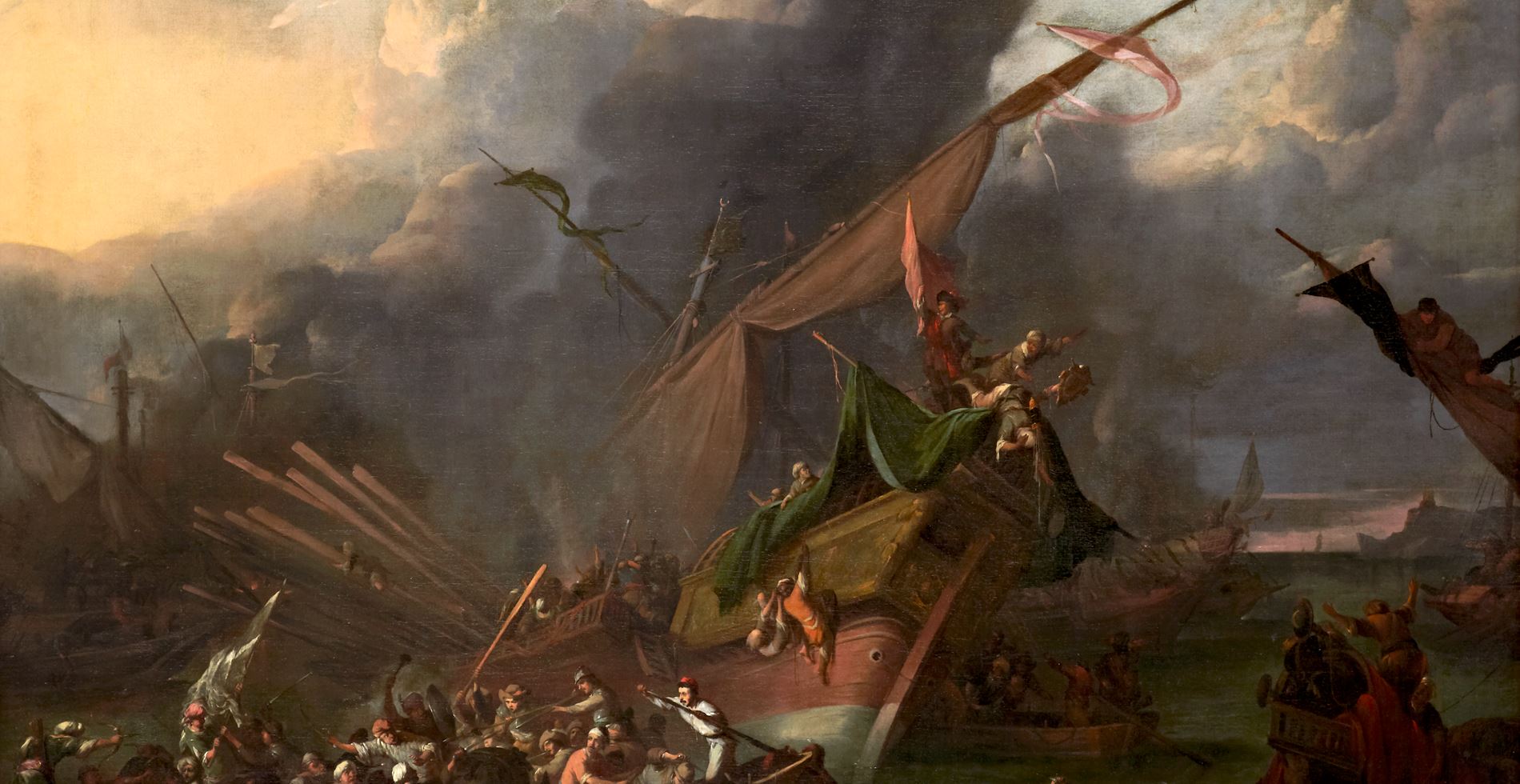
 contact
contact +44 20 7313 8040
+44 20 7313 8040


